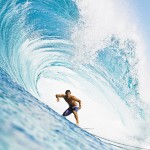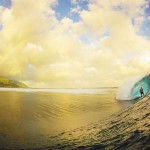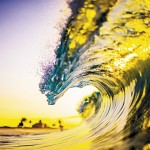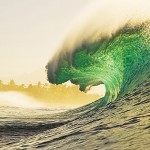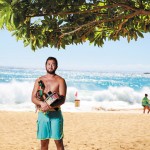A Watery View
In a busy stretch of traveling last year, Zak Noyle made a particularly grueling trip to Indonesia — he’d had to fly from Honolulu to Los Angeles, then take a 14-hour plane ride to Taiwan, followed by a six-hour flight to Jakarta, then drive for 11 hours through the night, before jumping on a boat for eight hours. The pace, he admits, was a bit crazy — but completely worth it: It was all in the name of reaching a remote surf break, and when he finally did arrive, he was greeted by some of the best waves he’d ever seen in his life.
Noyle’s not a pro surfer; he shoots them. As a surf photographer, Noyle chases waves throughout the world — Puerto Rico, Tahiti, Mexico, Fiji and Japan all were on his itinerary just within the last couple of years. At 30, he already has been shooting professionally for nearly a decade. His images have appeared in publications including National Geographic and ESPN magazines. Currently, he is a staff photographer at Surfer Magazine.
His love for photography began first with a love for the ocean. Noyle grew up bodyboarding, surfing and swimming — “anything to be in the water,” he says — and later swam and played water polo in high school at Punahou. It’s that passion and competence, perhaps, that has allowed Noyle to set himself apart. He isn’t afraid to go to sometimes extreme lengths to get the perfect image. As a result, his work is vibrant, energetic — and serves, he hopes, as a way to bring viewers into the water.
“Not everybody can be at the places that I go to shoot,” Noyle says. “And so to be able to bring something back that puts the viewer there is one of the most rewarding things that I get to do.”
- Steph Koehne at Off The Wall ZAK NOYLE PHOTO
- Noyle with grandfather Ken (center) and father Ric DENISE NOYLE PHOTO
- Christian Redongo at Teahupo‘o in Tahiti ZAK NOYLE PHOTO
Coming from a long line of photographers — his father, grandfather and great-grandfather — as a kid, Noyle often would assist his father Ric, a commercial and lifestyle photographer, on assignments. Noyle would help with tasks like carrying camera stands or moving lights around. But he wasn’t exactly keen on it.
“My joke was always that unless I had really good food or great-looking women, he wasn’t that interested,” Ric recalls.
Noyle had shot with his dad’s cameras and even took a photography class at school (which Ric says he did “terribly” in), but that casual interest intensified when he discovered shooting could be a water activity, too. (As Ric tells it, Noyle’s early experiments did not go well; the first time he attempted to get underwater images, he ended up breaking Ric’s Super 8 camera.)
“Shooting photos in the ocean and being able to come back and show someone like my mom these images that she would never be able to go into the ocean and see — that is what really made me fall in love with it,” Noyle recalls.
In those early days, Ric was there to help, buying Noyle his first camera — a $50 Canon from a pop-up flea market — and showing him the basics. (Today, Ric has a 30×40 print of one of Noyle’s earliest shots from Makapu‘u hanging in his living room.) But Ric credits his son’s innate talent for his success.
“He’s got a magic eye,” Ric says.
- A shot from Sandys ZAK NOYLE PHOTO
- Waves breaking at Pipeline ZAK NOYLE PHOTO
- Zak Noyle at Sandys, one of his favorite spots to swim and shoot BODIE COLLINS PHOTO
Noyle published a number of photos when he was still in high school, and went on to do a stint at Transworld Surf. He was hired by Surfer Magazine when he was just 25. Noyle also does commercial work, including ad campaigns for big-name clients like Billabong, Chanel, Lululemon, Stussy and most recently, Apple, in which photos he shot on his iPhone6 were selected to be a part of an international billboard campaign. And his photos even have their own merchandise line, including iPhone cases and skateboards.
In composing an image, Noyle starts by conceptualizing what type of shot he wants to see.
“When I see the waves, I can see what lens or what look I want to get, and it’s something I can visualize ahead of time,” he explains.
But that sort of pre-planning, of course, has its limitations. “The waves will be whatever they are going to be; you can’t predict Mother Nature. Every wave is different, and every moment. It might not work out that way (you plan), but it could be something better, or different than what you expect.”
Crafting a shot in the water, then, is partly trying to orchestrate the near-impossible: being in the right place at the right time.
Noyle aims to create photos that display the “in-your-face power of a wave.”
To get those types of shots, he’s an athlete himself; he trains daily — swimming, biking, practicing hot yoga — in order to maintain the stamina required to be in the water for hours. Usually when he shoots, Noyle is right there swimming alongside the surfers, with nothing but his camera and his fins.
For Noyle, staying in shape is part of the job — a sort of prerequisite for his penchant for dogmatic pursuits of nailing the perfect image. Like the one morning last fall when he arrived at Pipeline to find ideal conditions. He jumped right in the water — and didn’t get out for another eight hours. He wouldn’t leave, not even for a quick rest or some water, until he got what he was looking for.
“It was really big and really good, and I didn’t want to miss a moment,” he explains. “You could come in, eat something, relax, and the conditions could change and it could be junk for weeks.”
Another time, on the last day of an assignment in Tahiti, he’d had a particular image in his mind. Getting it, though, was a little precarious. “It was a very dangerous angle because you’d get very deep in the wave,” he explains.
All of the other photographers were huddled in one area, in a safer spot. But Noyle went for it — he swam deep into the wave, leaving the others far in the distance. He got the shot, and it ended up on the cover of Surfer.
Since Noyle covers Hawaii and the Pacific for Surfer, here is still his home base, technically. But for a chunk of the year, his is a practically itinerant existence. With constantly changing wave conditions, Noyle tracks swells at potential destinations — and then buys tickets at the last minute, just to be sure.
This year alone has been a blur of travel for Noyle — he went from trip to trip, sometimes returning home for only a day before heading out again.
Right now, though, he’s posted up at a beach house on the North Shore, where he primarily spends the winter surf season. (“Literally, from my bed, I can see Pipeline breaking — it’s great,” he says.)
He’ll be there through February, snapping photos of the huge winter waves that are starting to roll in. He’s scheduled to shoot the Quiksilver in Memory of Eddie Aikau contest, which hasn’t run since 2009, when Noyle shot it for the first time. The Eddie pits surfers up against 40-foot wave faces — at the minimum — and Noyle will be out there at Waimea Bay with them. (The holding period for the contest starts Dec. 1 and lasts through the end of February.)
“It was one of the best things I have ever shot,” he says. “I remember going when I was growing up and being taken out by my dad to go watch it. There are larger waves in the world, but with the prestige and what it stands for, it was such an honor to be in the water shooting. It is just an amazing event to be a part of.
“I am lucky that I don’t have to go anywhere, and I can just be home for now,” he adds.
All that travel sounds glamorous — and Noyle repeatedly says he loves it — but there also are the more mundane realities of being on the road all the time. There’s missed connections, delays and long layovers, and a lot of traveling alone.
“I have learned to sleep wherever,” he says.
He adds quickly, “I can’t complain. I get to do what I love every day and get to be in the water.”
If it sounds for a second like Noyle is anything but stoked, that second is over quickly. In a way, his work traveling is paralleled in the way that he goes about shooting anything: It’s all a kind of cost-benefit analysis — he goes where he thinks he can get the best shots, while knowing that he may be missing something somewhere else.
And when asked if he has a favorite moment from his breadth of travel and adventure, it’s ahead he’s looking:
“It is just the point of living in the moment, and finding that next moment that I want to live in, or that next image that I want to create — and then moving onto the next and always evolving.”
For more on Zak Noyle and to view more of his work, visit zaknoyle.com.


